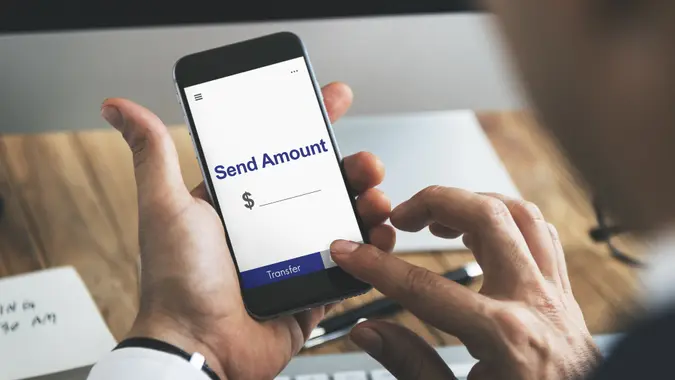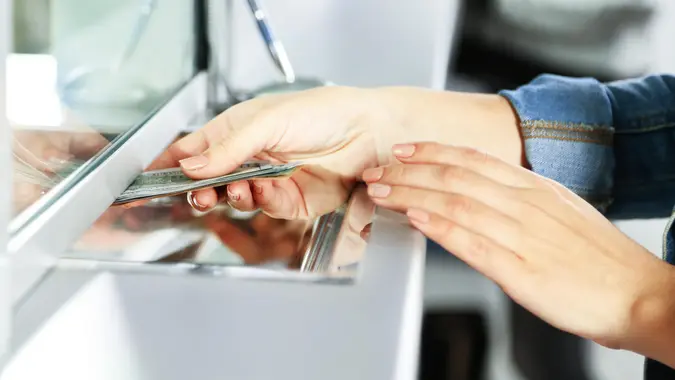6 Key Ways Banks Can Help You Manage Your Cash Flow

Commitment to Our Readers
GOBankingRates' editorial team is committed to bringing you unbiased reviews and information. We use data-driven methodologies to evaluate financial products and services - our reviews and ratings are not influenced by advertisers. You can read more about our editorial guidelines and our products and services review methodology.

20 Years
Helping You Live Richer

Reviewed
by Experts

Trusted by
Millions of Readers
Most people don’t think too much about their banks or the banking services that might be available. They might use an app or go online to check their balances or transfer money from checking to savings and maybe sometimes pay bills or use e-payment features to cover a night out, but it usually doesn’t go much further than that.
There’s probably a lot more you can do with the services your bank has at your disposal. Keep reading for a look at some of the potentially underused and overlooked ways your bank might be able to help you manage your finances, save you money and even help increase your personal wealth.
High-Yield Interest-Bearing Accounts
Not all banks offer high-yield savings accounts, but they are relatively common features of online-only banks, and it’s likely just a matter of time before conventional brick-and-mortar banks have to match interest rates to stay competitive.
These are interest-bearing accounts that pay in the range of 5% APY on deposits, which is a lot more than the 0.01% to 0.025% that traditional banks pay on accounts of the same kind. Even if your primary bank doesn’t offer these kinds of rates, there are few barriers to opening a secondary account at a bank that does. Bear in mind that current inflation rates are around 3%, so if your savings account isn’t paying at least that much, your money is losing value just by sitting there.
Overdraft Protection
This has been a relatively common feature of banking for some time now, but many customers don’t take advantage of it. In its simplest form, overdraft protection means a bank will cover any checks or debit charges when there are insufficient funds in your account, but generally only up to a preset amount, and there are typically charges associated with the service.
Most banks will expect a customer to deposit enough money in the primary account to cover these overages within a day or so, but details will differ from bank to bank. Some banks also offer overdraft protection tied to a savings account or line of credit, which can be a good way to cover unexpected shortfalls.
Automated Savings
It’s never a bad idea to save, whether to have an emergency reserve to cover unforeseen expenses, for a large purchase like a home mortgage or new car or to set aside money for investment. It’s the kind of thing many people mean to do but often forget.
There’s a way to make it effortless. By setting up automatic savings at your bank, you can have a set percentage or dollar amount of every deposit automatically transferred to savings. This is an even better option if you have direct deposit set up, as you won’t miss the money.
Cash Management Accounts (CMA)
A cash management account is a sort of hybrid between checking and investment accounts. You can fund investments with it and leave a certain amount “liquid” or not tied up in stock positions so you can draw on it as needed.
The details will differ from bank to bank, and the interest offered may not be as attractive as some high-yield accounts, but if you want the simplicity of having a single deposit account from which to invest, this is a good bet.
Financial Planning Services
Many people may think of financial planning as a service only offered by independent professionals, but many banks also have financial planning services ranging from investment to retirement and even estate planning.
Your bank may charge fees for these services, though some banks may offer them free of charge to customers with a certain set minimum amount on deposit. There are also automated financial planning tools available on many bank websites or through an app provided by the bank, so you may also want to look into what’s available through your bank.
Loyalty and Rewards Programs
Though you might associate loyalty and reward programs with credit cards, banks offer them too, and some of the benefits can be considerable. Though there are generally requirements banking customers have to meet before these rewards kick in, some programs have perks such as increased interest rates on savings accounts, higher credit limits on bank-issued credit cards and even travel benefits like frequent flyer miles and discounted vacations.
There may be fees for some levels of reward packages, but the benefits can outweigh the costs considerably. If you keep a large amount of money in the bank and travel frequently or could use a substantial amount of credit, these programs might be worthwhile.
 Written by
Written by  Edited by
Edited by 
























